


Article from the magazine «HOLIDAY», June 1946



THE SKYFARES who step aboard the new planes now being put into passenger services on the air lines have more surprises waiting for them than the speed of getting from here to there.
 In addition to speed and safety, according to Capt. Eddie Rickenbacker, veteran pilot and head of Eastern Air Lines, passengers want a lot of luxuries and comforts — and they are going to get them in the new planes being introduced, being built, or still on the drawing boards. Either available or in the offing are such things as plane-to-ground telephone services, and later, television. There will be insulation from engine noise, more head and leg room. You can expect talkie-movies in the cabin. Individual radios. Frozen dinners, electronically heated in two minutes. A blister in the bottom of the plane for baggage; a push button will deliver your luggage, eliminating waiting around the airport. Flights will be high — between 20,000 and 25,000 feet, where the going is smooth and the storm incidence is low. Tricycle landing gear, which makes the plane level at all times, will be universal.
In addition to speed and safety, according to Capt. Eddie Rickenbacker, veteran pilot and head of Eastern Air Lines, passengers want a lot of luxuries and comforts — and they are going to get them in the new planes being introduced, being built, or still on the drawing boards. Either available or in the offing are such things as plane-to-ground telephone services, and later, television. There will be insulation from engine noise, more head and leg room. You can expect talkie-movies in the cabin. Individual radios. Frozen dinners, electronically heated in two minutes. A blister in the bottom of the plane for baggage; a push button will deliver your luggage, eliminating waiting around the airport. Flights will be high — between 20,000 and 25,000 feet, where the going is smooth and the storm incidence is low. Tricycle landing gear, which makes the plane level at all times, will be universal.
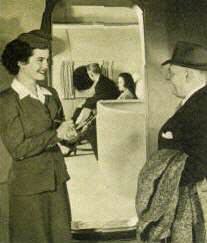 "With these ships," concluded Captain Eddie, "we can loaf at three hundred miles an hour with sixty per cent of our power in reserve. It's as if your car, although capable of doing a hundred, were always driven at forty. Your engine would never be subjected to maximum stresses."
"With these ships," concluded Captain Eddie, "we can loaf at three hundred miles an hour with sixty per cent of our power in reserve. It's as if your car, although capable of doing a hundred, were always driven at forty. Your engine would never be subjected to maximum stresses."
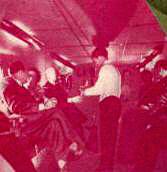 What does all this super-plane building, fostered by know-how accumulated from America's fantastic warplane production, mean to you and me, average travelers with a wanderlust likewise whipped up by the global war? What will transcontinental and transoceanic travel be like tomorrow and in months to come? How long will it take to go wherever we wan to go? How soon can we start, and what will we have to pay?
What does all this super-plane building, fostered by know-how accumulated from America's fantastic warplane production, mean to you and me, average travelers with a wanderlust likewise whipped up by the global war? What will transcontinental and transoceanic travel be like tomorrow and in months to come? How long will it take to go wherever we wan to go? How soon can we start, and what will we have to pay?
 The Lockheed Constellation, first of the superairliners to be placed in scheduled service, already has answered some of these questions. TWA's initial "Connie" cut the time from Los Angeles to New York to seven hours, twenty-seven minutes. TWA pilots in their first Constellation flight over the Washington-Paris route whittled the time to twelve hours, fifty-seven minutes. Pan American flew the New York-Bermuda run in two hours, twenty-two minutes, and form New York to Ireland in ten hours and thirty-eight minutes.
The Lockheed Constellation, first of the superairliners to be placed in scheduled service, already has answered some of these questions. TWA's initial "Connie" cut the time from Los Angeles to New York to seven hours, twenty-seven minutes. TWA pilots in their first Constellation flight over the Washington-Paris route whittled the time to twelve hours, fifty-seven minutes. Pan American flew the New York-Bermuda run in two hours, twenty-two minutes, and form New York to Ireland in ten hours and thirty-eight minutes.
 These records mean that the winter vacationer can hop from freezing New England to balmy Palm Springs in eight to ten hours. In summertime, the Canadian Rockies or Alaska are overnight from anywhere in the U.S.A. Europe is almost as feasible for week-ending as Bermuda.
These records mean that the winter vacationer can hop from freezing New England to balmy Palm Springs in eight to ten hours. In summertime, the Canadian Rockies or Alaska are overnight from anywhere in the U.S.A. Europe is almost as feasible for week-ending as Bermuda.
 Tomorrow's planes have not only shrunk the globe to about the size of Texas, in point of time, but they have outmoded the old school geography. Chicago, St. Louis, Denver, are world ports, quite as much as New York, New Orleans, San Francisco. For flight to many cities in Northern Europe, for example, Chicago is the logical take-off port.
Tomorrow's planes have not only shrunk the globe to about the size of Texas, in point of time, but they have outmoded the old school geography. Chicago, St. Louis, Denver, are world ports, quite as much as New York, New Orleans, San Francisco. For flight to many cities in Northern Europe, for example, Chicago is the logical take-off port.
Boeing's planers have produced some revealing figures showing how far the other place is from where you are via Stratocruiser. London is estimated at eight hours, thirty-three minutes from New York; San Francisco, twenty-one hours from Tokyo; Buenos Aires and Philadelphia, twenty-one hours apart; Sidney, Australia, twenty-seven hours from San Francisco. Halfway round the globe to Calcutta would be only thirty-six hours. At three hundred miles an hour or better, anyplace a plane can land is within holiday range.
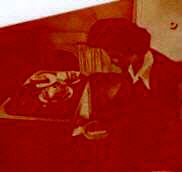 First rates announced by air lines for the new sky liners are high. This is partly because air travel costs, including overhead, can be determined only by experimental operation; partly because foreign countries, fearing U.S. competition, have insisted on high rates for transoceanic flights. The British, for instance, cut Pan American to two weekly flights when the company announced a $275 New York to London fare. So Pan American settled on a daily flight at $375. Finally, there aren't yet enough Tomorrow's Planes to handle the traffic, even at high rates. By this year's end, Lockheed will have delivered 100 Constellations to air lines.
First rates announced by air lines for the new sky liners are high. This is partly because air travel costs, including overhead, can be determined only by experimental operation; partly because foreign countries, fearing U.S. competition, have insisted on high rates for transoceanic flights. The British, for instance, cut Pan American to two weekly flights when the company announced a $275 New York to London fare. So Pan American settled on a daily flight at $375. Finally, there aren't yet enough Tomorrow's Planes to handle the traffic, even at high rates. By this year's end, Lockheed will have delivered 100 Constellations to air lines.
 Air-line operators believe that the big planes will bring travel costs down, eventually. At present they average four and a half cents a mile. C.R. Smith, Chairman of the Board of American Airlines, foresees the day of three-cents-a-mile air travel, as low as, or lower then, comparable rail transportation. Even at that rate, 300-miles-an-hour skyriding can run into money — $216 for every twenty-four hours aloft.
Air-line operators believe that the big planes will bring travel costs down, eventually. At present they average four and a half cents a mile. C.R. Smith, Chairman of the Board of American Airlines, foresees the day of three-cents-a-mile air travel, as low as, or lower then, comparable rail transportation. Even at that rate, 300-miles-an-hour skyriding can run into money — $216 for every twenty-four hours aloft.
 Before they can cut rates, the air-line operators fear they must curtail luxuries, or make the passengers pay for them. Meals, for instance. It costs $1.07 to serve a passenger a hot box meal from the present compact galleys, which are designed to keep hot the food prepared in kitchens on the ground. Meals will be prepared aloft in the new kitchens of tomorrow's planes and will be even more expensive. The question is, should the patrons pay separately for meals and snacks, as they do on railway diners, or pay for them in the ticket, as on ocean liners?
Before they can cut rates, the air-line operators fear they must curtail luxuries, or make the passengers pay for them. Meals, for instance. It costs $1.07 to serve a passenger a hot box meal from the present compact galleys, which are designed to keep hot the food prepared in kitchens on the ground. Meals will be prepared aloft in the new kitchens of tomorrow's planes and will be even more expensive. The question is, should the patrons pay separately for meals and snacks, as they do on railway diners, or pay for them in the ticket, as on ocean liners?
 When the new sky giants are in general service one uncertainty of air travel will virtually vanish — weather. Use of radar and other equipment, developed and proved in wartime, almost wipes out this hazard. ATC pilots proved over the North Atlantic, which probably has the worst flying weather of any major air lane, that they could fly every hour on the hour, day in, day out. A compact little weather-making unit aboard the Constellation will keep the cabin at 75º through freezing climate at 25,000 feet, or through baking heat on a desert airport.
When the new sky giants are in general service one uncertainty of air travel will virtually vanish — weather. Use of radar and other equipment, developed and proved in wartime, almost wipes out this hazard. ATC pilots proved over the North Atlantic, which probably has the worst flying weather of any major air lane, that they could fly every hour on the hour, day in, day out. A compact little weather-making unit aboard the Constellation will keep the cabin at 75º through freezing climate at 25,000 feet, or through baking heat on a desert airport.
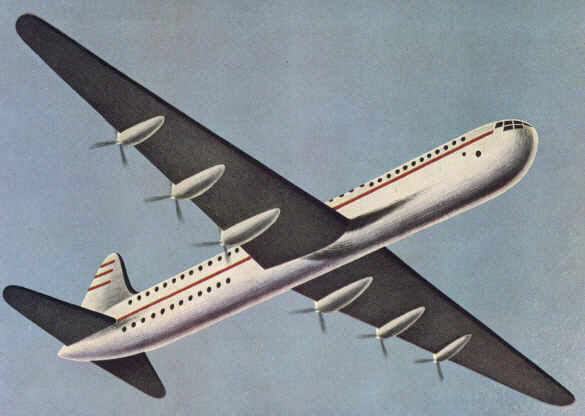 Longer range in flight — up to 4200 miles for the Stratocruiser — means we have to revise another notion. The air-line distance between two points will become the shortest distance, which it isn't now. The actual distance form New York to Mexico, D.F., for instance, is 2110 miles, if a crow ever flew it. The airplane rout is 2476 miles, a series of dog-legs from beam to beam. Tomorrow's Planes will climb, set a course an hold it — except for slight changes with which only the crew need concern themselves — because they have the range to get there in one high, fast hop.
Longer range in flight — up to 4200 miles for the Stratocruiser — means we have to revise another notion. The air-line distance between two points will become the shortest distance, which it isn't now. The actual distance form New York to Mexico, D.F., for instance, is 2110 miles, if a crow ever flew it. The airplane rout is 2476 miles, a series of dog-legs from beam to beam. Tomorrow's Planes will climb, set a course an hold it — except for slight changes with which only the crew need concern themselves — because they have the range to get there in one high, fast hop.
I was fortunate enough to ride in a Constellation during a demonstration for a prospective customer. Told to be at the field at three, I was there at a quarter to. This was flight not to miss.
We gathered at the ready room, talked with the tests pilots, hat some coffee and doughnuts, then rode out in station wage to Tomorrow's Plane, as the Lockheed executives refer to the Constellation. Other aircraft builders have their versions of Tomorrow's Plane too. Boeing has the Stratocruiser, Douglas the Globemaster, Consolidated Vultee is working on a six-engine 200-seat colossus, and there are others in the imagineering stage.
Connie is shaped like a sleek, silvery, winged porpoise. Her nose points down, there is slight hump in her back, and she tapers to her tail, which has an upswing like a porpoise's. That may sound odd, but she's graceful and beautiful, the last word in aerodynamics, according to engineers.
We climbed the dozen steps of the landing platform, stepped into the high-slung craft, sank into plush seats, fastened our seat belts and looked around at the big, spacious cabin. Up front was a lounge; ahead of that the crew's cabin. The motors roared, the ship leaped down a third of the runway, then shot upward like a Lightning, in spit of her 90,000 pounds.
That's another astonishing thing about the new sky giants. They take off and land in less space than yesterday's smaller aircraft. They are aerodynamically superior. The Constellation can slow form 300 to eighty miles an hour and land on runways too short for standard twin-engine transports. After we were a mile high, the pilot cut two engines and demonstrated in simulation how Connie could make a safe take-off even with half its power plants inoperative. Connie sill climbed with speed to spare. The he cut tow on the same side — a more drastic test — and put her through maneuvers for which a fighter craft is designed. He slowed down the big craft until it bounced an jerked in a stall — the point at which an aircraft, due to loss in speed, stops flying. The he gave the engineers the gun, and she leaped right out of the stall. He Zoomed up to 20,000 feet, dived down to 10,000, repeating the performance. At that point I should have passed out from altitude sickness — lack of oxygen. But I didn't fell a qualm. the automatic pressurization equipment kept the atmosphere inside the big ship equal to that of normal air at 8000 feet, and temperature remained constant too.
Not many passengers who buy a ticket and board a Constellation will experience the stunts that this particular Connie went through. But the test dramatized the comforts, safety factors and the speed of Tomorrow's Planes toe everybody aboard. The aircraft engineers have concentrated in them the harvest of know-how they gleaned through building bombers, fighters and transports to win the war: A quarter century of experience in four or five years.
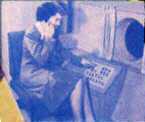 The Constellation has no monopoly on luxury, safety and speed. Boeing's Stratocruiser, which is a peacetime sister plane of the B-29 Superforts, hung up new cross-country transport-plane record on its maiden flight. Designed for the AAF, it is a double-decker, with one fuselage atop the other, so to speak, and an tail as high as a four-story building. From the front the fuselage looks like a figure eight. Using B-29 wings, it was designed to carry a lot of people or a lot of cargo, fast. Cruising speed is 340 miles an hour, top speed considerably higher. It can fly at 25,000 feet, with pressurized cabin for 114 sitting passengers, or sixty in berths. It has long range, up to 4200 miles. Three were finished in the rugged military model, but Pan-American will soon have twenty in the luxury version.
The Constellation has no monopoly on luxury, safety and speed. Boeing's Stratocruiser, which is a peacetime sister plane of the B-29 Superforts, hung up new cross-country transport-plane record on its maiden flight. Designed for the AAF, it is a double-decker, with one fuselage atop the other, so to speak, and an tail as high as a four-story building. From the front the fuselage looks like a figure eight. Using B-29 wings, it was designed to carry a lot of people or a lot of cargo, fast. Cruising speed is 340 miles an hour, top speed considerably higher. It can fly at 25,000 feet, with pressurized cabin for 114 sitting passengers, or sixty in berths. It has long range, up to 4200 miles. Three were finished in the rugged military model, but Pan-American will soon have twenty in the luxury version.
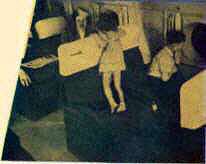 What intrigues passengers is the double-deck arrangement. A winding staircase connects the upper deck, where seats and berths are located, with the lower deck, where Boeing designers dreamed up the lounge, dining room and galley. Some designers refer to the rear cabin as the cocktail lounge. But so far, air-line operators say alcohol and altitude don't mix.
What intrigues passengers is the double-deck arrangement. A winding staircase connects the upper deck, where seats and berths are located, with the lower deck, where Boeing designers dreamed up the lounge, dining room and galley. Some designers refer to the rear cabin as the cocktail lounge. But so far, air-line operators say alcohol and altitude don't mix.
 The Douglas Globemaster is a seventy-seven-ton giant which could circle the globe in two hops, although it will probably never do that. It is designed for 108 sitting passengers and a crew of thirteen. It, too, will cruise at 300 miles or faster. In the Douglas plant, the Globemaster is regarded as a stepping stone to Day-after-Tomorrow's Plane — the DC-8. The latter, still on paper, will have a power set-up and profile similar to an experimental bomber nicknamed the Mixmaster, because it has counter-rotating propellers in the tail, the power being delivered by shafts. This innovation promises still greater speed, less noise in cabins, and better view.
The Douglas Globemaster is a seventy-seven-ton giant which could circle the globe in two hops, although it will probably never do that. It is designed for 108 sitting passengers and a crew of thirteen. It, too, will cruise at 300 miles or faster. In the Douglas plant, the Globemaster is regarded as a stepping stone to Day-after-Tomorrow's Plane — the DC-8. The latter, still on paper, will have a power set-up and profile similar to an experimental bomber nicknamed the Mixmaster, because it has counter-rotating propellers in the tail, the power being delivered by shafts. This innovation promises still greater speed, less noise in cabins, and better view.
 Consolidated-Vultee engineers likewise are pioneering drastic innovations in their forthcoming sky colossus — Model 37 — designed for 204 passengers and 15,000 pounds of baggage, mail and express. The six monster engines in the trailing edges of the wings are pushers, calculated for a cruising speed of 342 miles an hour.
Consolidated-Vultee engineers likewise are pioneering drastic innovations in their forthcoming sky colossus — Model 37 — designed for 204 passengers and 15,000 pounds of baggage, mail and express. The six monster engines in the trailing edges of the wings are pushers, calculated for a cruising speed of 342 miles an hour.
So Tomorrow's Planes make the whole world the traveler's oyster. Two-week vacations down under or around the globe, with only two or three days out for travel time, are a reality. Thousand-mile week-ends are a cinch. That's what it means to skyride at three hundred miles an hour.